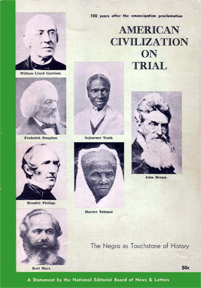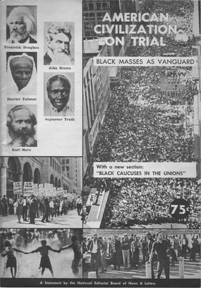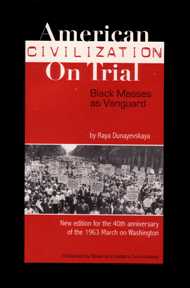|














|
|
|
NEWS & LETTERS, January - February 2013
From the Writings of Raya Dunayevskaya: 150 years after the Emancipation Proclamation
American Civilization on Trial:
Black masses as vanguard and the dialectic of history
Editor's note: This year marks the 50th anniversary of the publication of the Marxist-Humanist classic American Civilization on Trial, originally with the overline "100 Years after the Emancipation Proclamation," whose 150th anniversary was January 1, 2013. The original subtitle, "The Negro as Touchstone of History," was changed in later editions to "Black Masses as Vanguard." Written by Raya Dunayevskaya, the pamphlet was issued as a statement by the National Editorial Board of News and Letters Committees. To mark this double anniversary, we present the Political Letter Dunayevskaya wrote on April 15, 1963, titled, "American Civilization on Trial, as Statement of Our Views and as Basis for Follow-Up Studies and Articles." It can be found in the Raya Dunayevskaya Collection, #3082-87. Between the writing of this letter and the pamphlet's publication in May 1963, minor changes were made to the table of contents and to the passage quoted below. Except as noted, those changes have been incorporated here. All footnotes were added by the editors.
Dear Friends:
It is seldom that any of our Political Letters deal with internal rather than external events. This one will do so for two basic reasons, which are of the utmost importance for our organizational growth: (l) it is imperative that each and every one of us internalize American Civilization on Trial so that we can, at a moment's notice, make a comprehensive presentation of these views to outside groups and individuals; (2) it is equally important that we do not consider this pamphlet as a "finished work," but that we constantly expand it, reinterpret it, and bring it up to date.
   American Civilization on Trial, first edition, May 1963, 1970 edition, and 2003 edition
American Civilization on Trial, first edition, May 1963, 1970 edition, and 2003 editionFor example, on the day--Friday, April 12--when I was to make a presentation of it to the Detroit local, news dispatches announced that Switzerland had expelled one Erich Rajakovic, Adolf Eichmann's right-hand man, who had been responsible for the murder of 110,000 Dutch Jews, including Anne Frank. Despite all the tears that had been shed over the Diary of Anne Frank, as a book, as a play, as a movie, which may have equaled the tears shed over Eliza trying to escape over the ice as she was pursued by the hound dogs, [1] the Storm Trooper Rajakovic easily melted into the crowd at Munich, Germany, and made good his escape; while, at the same time, in our South, the savage use of savage dogs against the Freedom Fighters of today made it impossible for any of them to escape that dragnet. In a word, not only does the todayness of history make possible the presentation of American Civilization on Trial as a living document, but the one-worldedness of today allows for its application on an international scale.
Toward both these ends, I wish, first, to present the title and contents page of the pamphlet in its final form as it is now going to press:
100 Years after the Emancipation Proclamation
American Civilization on Trial
Negro as Touchstone of History
Introduction
1. Of Patriots, Scoundrels and Slave Masters
2. Compelling Issues at Stake
Part I. From the First through the Second American Revolution
1. Abolitionism, First Phase: From "Moral Suasion" to Harpers Ferry
2. Abolitionism, Second Phase: The Unfinished Revolution
Part II. The Still Unfinished Revolution
1. Northern Labor Struggles to Break Capital's Stranglehold, 1877-97
2. 11/4 Million Forgotten Negro Populists
3. Populism and Intellectual Ferment [2]
Part III. Imperialism and Racism
1. Rise of Monopoly Capital
2. Plunge into Imperialism
3. Racism
4. New Awakening of Labor: The IWW
Part IV. Nationalism and Internationalism
1. The Negro Moves North
2. Garveyism vs. Talented Tenth
3. Marxism
Part V. From Depression through World War II
1. The CIO Changes the Face of the Nation and Makes a Break in Negro "Nationalism"
2. March on Washington Movement
3. The Communists Oppose the Independent Negro Movement
Part VI. The Negro as the Touchstone of History
1. Urbanization of Negroes
2. The Two-Way Road to African Revolutions
Part VII. Facing the Challenge, 1943-1963
1. The Self-Determination of People and Ideas
2. The New Voices We Heard
3. What We Stand For--and Who We Are
*
Please note Part VI. Instead of being a sub-section under "What Now?" "The Negro as Touchstone" has not only become a full part, but it is no longer restricted to the American scene. That is to say, by including the section on the African Revolutions here, we are able to present the international role of the Negro. I hope many friends will wish to expand this section by various articles in News & Letters. The main points of expansion, however, will come on the American scene. In this respect, I would like to single out one of the additions I made in order to encourage others to take advantage of the condensed form of the pamphlet to elaborate on other phases of American development that we couldn't possibly go into, in tracing the dialectic of history that has never before been traced from a Marxist-Humanist viewpoint. I am referring to Part II--"The Still Unfinished Revolution"--where it was necessary to take note both of the economic determinist view of the Civil War as an "economic revolution," and to argue against the attitude that the Jefferson-Jackson-Lincoln tradition is fundamentally different from the "other" tradition: [3]
The new phase of Northern capitalist development had, of course, been a motivating force for the Civil War. But, the economic determinist view notwithstanding, it was not the propellant. The Second American Revolution was more than an "economic revolution." Much as the industrialists wished to break the monopoly of commercial over industrial capital, of American slavishness to British textile manufacturing, "cash and compromise" was too ingrained an element of American capitalism for the industrialists to venture forth into civil war. Only the most prodigious revolutionary exertions by slaves, Abolitionists and, in many of its stages, labor, could tear apart the power link of cash and compromise that bound together cotton and textiles; cotton growers, cotton shippers and financiers.
"If Lincoln has grown," wrote Wendell Phillips after the issuance of the Emancipation Proclamation, "it is quite natural. We watered him." At the same time, however, it was no accident that Lincoln chose Andrew Johnson as his running mate for the second term, in place of the Vice-President of the first term, Hannibal Hamlin, who was a friend of the Abolitionists. The objective compulsion of capitalist industrialization won over the freedom forces. [4] The Civil War brought to a climax and summed up the paradox of the Jefferson-Jackson-Lincoln liberal presidential tradition.
In office, Jefferson and the Jeffersonians were fulfilled Hamiltonians. In office, Jacksonian democracy turned out to be something very different from the rule of farmer and mechanic against Eastern finance capitalů.
In the same manner, Lincoln, in office, developed the "American System" more in line with the concept of the "Great Compromiser," Henry Clay, than in the spirit of a "Great Emancipator" heading the Second American Revolutionů.
It would be excellent if someone could develop the differences between the Abolitionists--wholly devoted to an idea, the idea of freedom, without wanting anything for themselves--and the Populists who fought for limited rights and could produce so contradictory a character as Tom Watson. [5] But, above all, where expansion is needed is in Part VII: Facing the Challenge, 1943-1963, especially the final section on "What We Stand For--and Who We Are."
In this way, American Civilization on Trial will bring to organizational consciousness the underlying philosophy of both the movement of history and its todayness.
Raya
____________
Notes:
1. In Harriet Beecher Stowe's novel Uncle Tom's Cabin, Eliza crosses the icy Ohio River to escape slavery.
2. As published, this section was incorporated into the previous section.
3. This passage appears on p. 40 of the 2003 edition of American Civilization on Trial.
4. This sentence did not appear in the published version.
5. The section on Populism in American Civilization on Trial (pp. 46-48) describes how Tom Watson, later to become "the typical white supremacist," advocated and acted for white and Black solidarity at the height of the Populist movement.
|

* * *

Subscription for one year
$5
|

